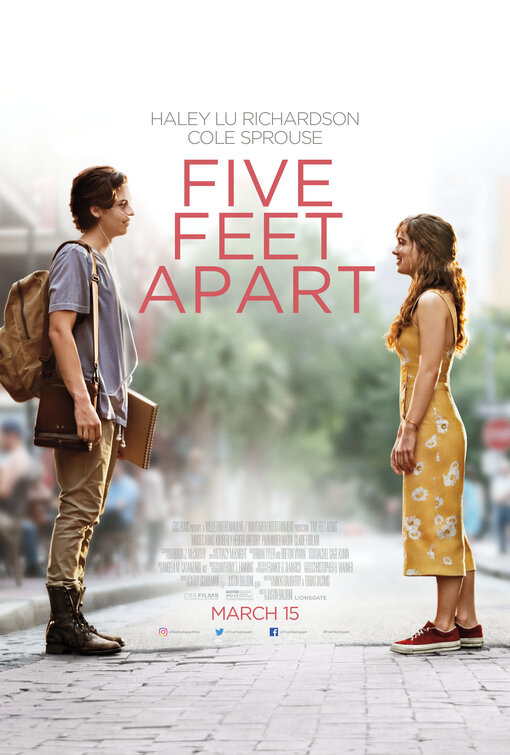Occasionally, I am at odds with many movie critics. Such is the case for Five Feet Apart, which I think is an excellent movie (as do most regular audiences watchers). The leads (Haley Lu Richardson, Cole Sprouse) are excellent, and have palpable chemistry on screen as two teenagers in advanced stages of a genetically inherited terminal illness (cystic fibrosis, or CF).
The movie’s title derives from standard CF treatment practice of minimizing airborne infection from others with the disease by staying six feet apart. Don’t worry, the movie explains the five foot modification, and it’s the heart and soul of the movie (as good titles should be; not bait and switch). For more on CF, which is actually quite complex, see the general overview here, https://en.wikipedia.org/wiki/Cystic_fibrosis
“Five Feet Apart” is much more than just good acting. Every scene is a meaningful and moves the story forward, either by driving plot or the arc of the characters. Moreover, the movie just doesn’t dwell on the victims of the disease: the story directs attention, well integrated into the plot, to the toll the disease takes on the caregivers and professionals who cope with the teenagers trying to manage their lives under the heavy weight of a terminal illness (with excellent performances by Kimberly Hebert Gregory as a nurse and Parminder Nagra as a doctor). We see unfolding before us love gained, love lost, love restored; doubt, perseverance, compromise; heartbreak, hope, defeat, determination, inspiration; all amid heartfelt struggles to find purpose and meaning. I think the screenwriters (Mikki Daughtry and Tobias Iaconis) and the director (Justin Baldoni) have done a remarkable job tying together these wildly dynamic strands and threads into this poignant tale of mental and physical survival. And Haley Lu Richardson, Cole Sprouse, and Moises Arias (their friend Poe) do a great job fulfilling their artistic and storytelling vision.
So, why do I think many critics missed the mark on “Five Feet Apart”? I suspect I bring a number of perspectives into the film that might put me more in touch with the target audience. As a YA novelist (four YA novels and counting), I have worked for years thinking about and putting into creative practice the personal and social psychology of teen behavior and attitudes. As an active parent, I witnessed my own children struggling with many of the issues that play out in “Five Feet Apart” (although in circumstances far less dire). But perhaps most importantly I have spent a lot of time trying to understand human sexuality and intimacy. “Five Feet Apart” gets all of this right.
So, is Five Feet Apart melodramatic? Certainly. So are teens’ lives. The difference is the melodrama is a critical (and necessary) part of growing up, and “Five Feet Apart” honors this essential element of human development. Audiences who like the movies probably see, as a did, the reality of their world in this story. Does the story meander? On the surface, yes. In terms of the story’s basic structure and drive toward the climax, no. It all fits and provides forward momentum for the story, leading the characters logically and rationally to their climactic scenes. Is the movie exploitive? No. the movie puts teens in an unimaginably (for most) heartbreaking situation that actually does play out in real life (although the prognosis for most afflicted with CF is much better than the movie implies).
Overall, I think Five Feet Apart is a fine film, one of the best I’ve seen in 2019. But be prepared: this movie is a true drama and the story’s ending is not all roses (or, to push the metaphor further a rose with many thorns).
Update 6/20/2019: Check out the Facebook post and comments: 5,72 people reached, 443 engagements, 307 reactions, 27 shares.
